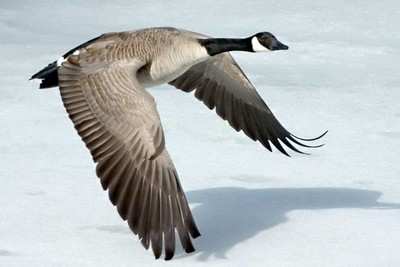Fri, Feb 13, 2009
Adult Birds Often Exceed Engine Ingestion Weight Standard
The National Transportation Safety Board confirmed Thursday the
bird remains found in both engines of
US Airways flight 1549 have been identified by
the Smithsonian Institution's Feather Identification Laboratory as
Canada Goose (Branta canadensis).

The lab made the identification for the NTSB through DNA
analysis as well as through morphological comparisons in which
feather fragments were compared with Canada Goose specimens in the
museum's collections; the microscopic feather samples were compared
with reference microslide collections.
A total of 25 samples of bird remains have been examined as of
Thursday. Additional analysis will be conducted on samples received
from the NTSB to attempt to determine if the Canada Geese were
resident or migratory.
While no determination has been made about how many birds the
aircraft struck or how many were ingested into the engines, an
adult Canada Goose typically ranges in size from 5.8 to 10.7
pounds, though larger individual resident birds can exceed
published records.
The accident aircraft was powered by two CFM56-5B/P turbofan
engines. The bird ingestion standard in effect when this engine
type was certified in 1996 included the requirement that the engine
must withstand the ingestion of a four-pound bird without catching
fire, without releasing hazardous fragments through the engine
case, without generating loads high enough to potentially
compromise aircraft structural components, or without losing the
capability of being shut down. The certification standard does not
require that the engine be able to continue to generate thrust
after ingesting a bird four pounds or larger.

NTSB investigators worked closely with wildlife biologists from
the United States Department of Agriculture, both at the scene of
the accident in New York City and during the engine teardowns at
the manufacturer's facility in Cincinnati, to extract all of the
organic material that was identified.
(Goose photo by Chuck Szmurlo)
More News
Light Gun A handheld directional light signaling device which emits a brilliant narrow beam of white, green, or red light as selected by the tower controller. The color and type of>[...]
"The journey to this achievement started nearly a decade ago when a freshly commissioned Gentry, driven by a fascination with new technologies and a desire to contribute significan>[...]
Aero Linx: JAARS, Inc. For decades now, we’ve landed planes on narrow rivers and towering mountains. We’ve outfitted boats and vehicles to reach villages that rarely se>[...]
"Our driven and innovative team of military and civilian Airmen delivers combat power daily, ensuring our nation is ready today and tomorrow." Source: General Duke Richardson, AFMC>[...]
Aircraft Conflict Predicted conflict, within EDST of two aircraft, or between aircraft and airspace. A Red alert is used for conflicts when the predicted minimum separation is 5 na>[...]
 ANN's Daily Aero-Term (04.20.24): Light Gun
ANN's Daily Aero-Term (04.20.24): Light Gun Aero-News: Quote of the Day (04.20.24)
Aero-News: Quote of the Day (04.20.24) ANN's Daily Aero-Linx (04.21.24)
ANN's Daily Aero-Linx (04.21.24) Aero-News: Quote of the Day (04.21.24)
Aero-News: Quote of the Day (04.21.24) ANN's Daily Aero-Term (04.21.24): Aircraft Conflict
ANN's Daily Aero-Term (04.21.24): Aircraft Conflict




